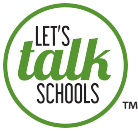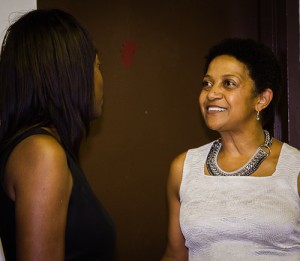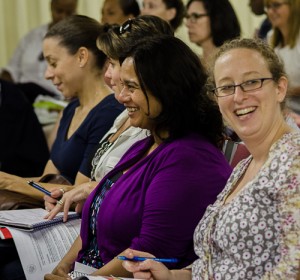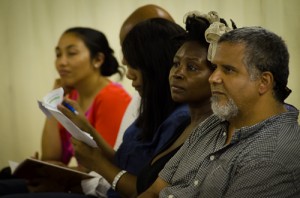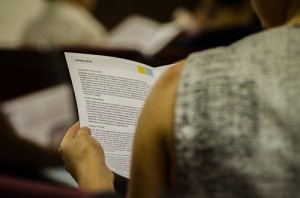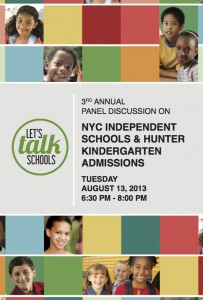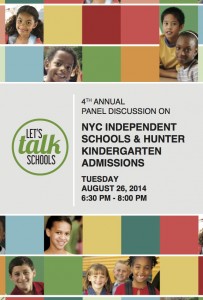 Mark your calendars to jump start your applications for kindergarten admissions to Hunter and NYC independent schools this year at our 4th Annual Private School Admissions Panel on Tuesday, August 26th @ 6:30 pm. Kindergarten is the main entry point for independent schools and the only time kids can enter Hunter Elementary School (entrance for the high school is in 7th grade.) There are many new changes to the independent school application process this year (can you say brand new AABL test?) and we will have a representative from the Electronic Records Bureau (ERB) on the panel to discuss them and answer your questions. If you have a four year old who will be attending kindergarten in 2015 this panel is for you. Admission directors will give an overview of the application process - what to do and when to do it. Be sure to register and get your tickets early!
Mark your calendars to jump start your applications for kindergarten admissions to Hunter and NYC independent schools this year at our 4th Annual Private School Admissions Panel on Tuesday, August 26th @ 6:30 pm. Kindergarten is the main entry point for independent schools and the only time kids can enter Hunter Elementary School (entrance for the high school is in 7th grade.) There are many new changes to the independent school application process this year (can you say brand new AABL test?) and we will have a representative from the Electronic Records Bureau (ERB) on the panel to discuss them and answer your questions. If you have a four year old who will be attending kindergarten in 2015 this panel is for you. Admission directors will give an overview of the application process - what to do and when to do it. Be sure to register and get your tickets early!
Category: Blog
Value-Added: Single -Sex Education for Girls
Kelly Bird Pierre is the former Director of Enrollment and Admissions, K–12 at The Hewitt School and current Lower School Principal at Friends' Central School She taught in co-ed lower school classrooms for 13 years before working in admissions at a single-sex school.
What is the value-added in a girls’ school? It is an intentional commitment to expand the range of what is possible for a girl. The gift that a single sex school gives a girl is space; space to explore, to experiment, to speak, to believe, to strengthen and to see herself reflected in the larger world. Our girls are prepared to do anything, but told that they need not do everything.
Our kindergarten girls walk into classrooms where each lesson and space is designed with their success in mind. The range of possibilities for the girls is immediately greater. As a former colleague observed, “At Hewitt, the block area is always open for girls.” Although many teachers in co-ed classrooms are careful to make things equitable, there are gender differences in how children play. The guideline that, “There must be two girls and two boys in the block area” may still not encourage girls to join because they don’t like the way the boys play with the blocks. There is a joy in building something as big as you can and knocking it down that is fun for some boys and not fun for some girls. Having spaces that are solely for them allows girls to move freely within their classroom and the school and to experiment more broadly within the program.
Unfortunately, we still live in a world in which voices of female leadership are scarce. In 2012 only 14.3% of women held Executive Officer positions in Fortune 500 companies.1 In my own classroom, I observed that boys will generally raise their hand before they think of their answer and girls often think of their answer before they raise their hand. Inherently, this is going to lead to more boys being called on unless a teacher waits…and waits. This only intensifies in co-ed settings as girls become more self-conscious of their changing bodies and sense of themselves, and, consequently, sometimes defer to boys even when they have the answer. Next time you are in a classroom, I encourage you to look at whose hands are in the air and who is talking. In a single sex school there is less competition for airspace, and quieter girls know there is room for their voices.
 Of course, many of our daughters will gravitate toward pink and Barbies no matter how hard we try to fight the gender stereotypes because we are immersed in a culture where gender stereotypes still thrive. The same is true for the subjects towards which girls and boys gravitate. We can look at how many women are represented in the STE2M (Science, Technology, Engineering, Environmental Sustainability and Math) fields to see this is true. Many boys expect to be good at math, which is half the battle of success. As my own second graders matured throughout the year, the girls would watch more boys join the enrichment math work at lunchtime, and my strongest girls would start to shy away from the work time. I worked hard to counteract girls’ too often tacit assumption that they should not be good at math. At a girls’ school, girls are the best at everything.
Of course, many of our daughters will gravitate toward pink and Barbies no matter how hard we try to fight the gender stereotypes because we are immersed in a culture where gender stereotypes still thrive. The same is true for the subjects towards which girls and boys gravitate. We can look at how many women are represented in the STE2M (Science, Technology, Engineering, Environmental Sustainability and Math) fields to see this is true. Many boys expect to be good at math, which is half the battle of success. As my own second graders matured throughout the year, the girls would watch more boys join the enrichment math work at lunchtime, and my strongest girls would start to shy away from the work time. I worked hard to counteract girls’ too often tacit assumption that they should not be good at math. At a girls’ school, girls are the best at everything.
The voices and roles of women are at the forefront of the experience in an all-girls school, and our students have the chance to see strong women in action today and in history. When third graders study biographies they are asked to choose an influential woman to read about, write about and then come alive as at a Living Museum. In high school, eleventh and twelfth graders choose from electives such as “Searching for Self” in which the girls read literature including Nadeem Aslam’s Maps for Lost Lovers and examine the unity of women in a hostile and repressive culture. Co-ed schools examine such texts as well, but in our AP English class the girls can question and debate sexuality, sexism and repression without having to defend their feelings and experiences. We provide them with the room to make sense of the world that they are on the brink of taking on as young women.

At Hewitt, we are not only providing many opportunities for our girls to study within the STE2M subjects, but we are constantly engaged in a dialogue about how girls learn these subjects best. 80% percent of wiring in the brain in gender-specific. And although one in five girls do not follow the research patterns, we need to acknowledge there are gender differences in the way girls and boys process information.2 Various studies, including one out of the University of Chicago, indicate differences in spatial skills, beginning as early as kindergarten.3 One of the hallmarks of our STE2M program is hands-on-learning that features these skills. Students are constantly given opportunities to build and design in three dimensions, to use carpentry tools, and to develop mechanical sense. And, as we move into the middle and upper school, the sophistication of these activities increases with the use of 3-D design programs, robotics, and collaborative work with experts in fields like architecture and engineering.
More importantly, girls are not just being immersed in every subject; they are working side-by-side with women in the STE2M fields. Before building bridges in class, our students tour the George Washington Bridge towers with female engineers. We are not just telling the girls you can do this; we are showing them they can do it. It gives the work our students are doing value and helps each girl imagine a possible future for herself. The assignment becomes a step toward something greater. This type of imprint is sure to change the number of women represented in the STE2M fields.
I have been asked, often by fathers, “Isn’t a girls’ school like going to school in a bubble?” “Yes,” I respond, “It is. It is a bubble that benefits girls tremendously. Girls leave Hewitt to go to mostly co-ed colleges and universities, lifted by that spacious bubble and emboldened to challenge assumptions that anything is out of reach for them.” I’ll never forget a Hewitt alumna telling me about raising her hand in a 300 freshman lecture class and a friend turning to her to say ‘How can you raise your hand?’” Her response? “Why wouldn’t I raise my hand?”
1 "Statistical Overview of Women in the Workplace." Catalyst. March 13, 2013. http://www.catalyst.org/knowledge/statistical-overview-women-workplace
2 "Understanding and Raising Girls." PBSParents. http://www.pbs.org/parents/raisinggirls/brains/nature.html
3 Harms, Bill. "Study Shows Early Sex Differences in Spatial-Learning Skills." The University of Chicago. November 18, 1999. <http://chronicle.uchicago.edu/991118/spatial.shtml>
Chloe The Yogi Brings Children’s Yoga To E-Books
 Yoga is a language spoken all over the world and means many things to different people and cultures. It even has it's own carousel of yoga languages - Ashtanga, Vinyassa, Jivamukti, Kundalini - different ways to yoga, but all have the same positive benefits for your health.
Yoga is a language spoken all over the world and means many things to different people and cultures. It even has it's own carousel of yoga languages - Ashtanga, Vinyassa, Jivamukti, Kundalini - different ways to yoga, but all have the same positive benefits for your health.
For my son and his friends, yoga has helped to develop their motor skills, calm and center them, help them to be aware of their bodies and improve their confidence. Lara Land of Harlem's Land Yoga has developed an ebook app, Chloe the Yogi: The Amusement Park, the first in a series of five, that mirror the experience of a children's yoga class. The story, featuring and animated character named Chloe, helps kids to learn yoga poses and reinforces the emotional support that children get through stretching, breathing, and role playing.
The app launches today, September 7th, with a special reading by Lara Land to the Harlem Community as part of the Harlem 4 Kids Saturday story time series at the Harlem Center PAL Building, 441 Manhattan Avenue. Event begins at 11am.
Namaste.
Jump-Starting the School Admissions Process for Your Child
 Our 3rd Annual Admission Panel took place last Tuesday in Harlem. Admission Directors from Hunter College Elementary School, Convent of the Sacred Heart, The Calhoun School and St. Bernard's School were on hand to answer questions and share some 'words of wisdom' on navigating the Hunter and private school admission process. Rachel Christmas Derrick, former Director of Development Communications & Publications at the Ethical Culture Fieldston School and Senior Writer at the Rockefeller Foundation, provides a great summary of the discussion.
Our 3rd Annual Admission Panel took place last Tuesday in Harlem. Admission Directors from Hunter College Elementary School, Convent of the Sacred Heart, The Calhoun School and St. Bernard's School were on hand to answer questions and share some 'words of wisdom' on navigating the Hunter and private school admission process. Rachel Christmas Derrick, former Director of Development Communications & Publications at the Ethical Culture Fieldston School and Senior Writer at the Rockefeller Foundation, provides a great summary of the discussion.
Jump-Starting the School Admissions Process for Your Child
by Rachel Christmas Derrick
Do stories of parents applying to seven or ten different schools keep you up at night? Does the thought of filling out all those applications make you want to pull the covers over your head each morning? Does the prospect of writing the essays and parent statements seem as daunting as applying to college or for a new job?
Take a deep breath and prepare to be pleasantly surprised: Applying to schools for your child doesn’t have to be an ordeal. In fact, with some planning, organization, and guidance, exploring how you get clomid and others see your child and your family can actually be big fun.
Here are some tips to help you jump-start the school admissions process:
- Do your homework! School websites can give you a sense of what makes each educational environment different from the rest.
- Don’t apply to a school simply because everyone you know is applying or it’s on some Top Ten list. Remember, there are lots of excellent schools out there—and you’ve never heard of many of them.
- See if your family’s values match those of the school. For instance, do you believe that allowing learning to be incidental to having fun can be detrimental in the long run? Or do you think that rigorously training a young child in the basics can have a negative impact?
- Keep an open mind. Even if you’re positive you want a co-ed school, for example, consider single-gender schools. If you’re convinced that a progressive education is the way to go, visit a more traditional school or two.
- Consider the neighborhood. If you live in Manhattan, you can antabuse certainly send your child to that phenomenal school with the main campus in Riverdale. However, make sure you’re comfortable with what that will mean for play dates, birthday parties, and long bus rides for your young child.
- Once you identify the schools that interest you, attend their tours and open houses. Take detailed notes of your impressions of each school, including the demeanor of teachers and other staff, the classrooms, the cafeteria, gym, and auditorium, the hallway artwork, the outdoor spaces, even the bathrooms.
- Feel free to ask administrators and teachers questions—but not those whose answers could easily be found on their websites.
- As you walk through each school, can you visualize you and your child as part of this community for the next 6, 9, or 13 years? Do teachers look happy? Do students seem engaged? Are children well-supervised?
- Remember, the “best” school is the one that feels right for your child and your family.
- Tailor your application essays or parent statements to each school and explain why YOUR child and YOUR family could be right for THAT particular school. A quick way to turn off an admissions team is to submit a generic essay, one that could be written to any school about any beloved child.
- If you’re applying for financial aid, don’t put down “$0” when asked how much your family can contribute to tuition. Schools are drawn to families who understand that your child’s education is a partnership that both you and the school have a stake in.
- Apply early! (Applications go online at the end of August or right after Labor Day.) Schools like enthusiastic, organized families who plan ahead. Even before you know what schools you’re applying to, get started on your basic essay. You’ll then be ahead of the game when it’s time to adapt it to the klonopin questions asked by each school.
Rachel Christmas Derrick is a widely-published writer and editor whose Words Rule! program helps guide families through the essay-writing process for school applications. For details, contact her at WordsRuleCommunications@gmail.com.
2013 NYS ELA and Math Test Results Released
The results for the 2013 New York State tests for ELA and math in grades 3 through 8 are out and the sky is falling. This year's test is brand new so comparisons to last year's results can't be done. New York is the only state in the country to use new common core tests, tests aligned to the common core standards. This is significant because curriculum based on the standards have not been developed yet. See where this is going?
Let's review - We have results from brand new tests based on brand new standards without complete curriculum. What could go wrong?
Before the tests were even administered the DOE started a big PR campaign to set expectations of much lower scores than past years. In fact, Commissioner John King predicted that the number of students deemed proficient would likely fall by 30 points.
He did not disappoint. Headlines from across the country chronicle the dismal results. Samples of test items were released along with the scores for all to see.
As parents, what do we tell our kids? Carol Burris, New York's 2013 High School Principal of the year writes:
...my advice to parents is this. Remember that these tests are hardly a measure of your child’s value or promise as a student. Be outraged if she is now labeled “below proficient” based on tests that were designed to have scores drop like a stone. Your conversations with your child’s teacher or principal can give you far better insights into her academic and (just as importantly) social and emotional growth.
Full article here.
We're about to start another school year with these test results used as a benchmark. Parents, we need to speak out and not settle for this corporate led, fast food, test driven version of education that we are being fed. We have the power to make change. What will you do?
Here's a round-up of other articles commenting on the test results.
Walcott: Common Core test results are about the future of our children, not adults (NY Daily News Opinion)
Chapman: Timeline for recovery of New York's reading, math scores uncertain as Common Core tests roll out (NY Daily News)
Mulgrew: Poor test results show Common Core curriculum was rushed (NY Daily News Opinion)
Failing kids – and voters (NY Daily News Editorial)
A test of honesty (NY Post Editorial)
Painful but necessary process (NY Post Opinion)
Punishing kids for adult failures (NY Daily News Opinion)
Musiowsky-Borneman: Teachers will have their work cut out for them as they prepare students for Common Core tests (NY Daily News Opinion)
Parent: Bloomberg's obsession with state tests should not replace real teaching, next mayor must make change (NY Daily News Opinion)
Goldstein: Common Core tests are not the answer in child-centered education (NY Daily News Opinion)
Less than one-third of city elementary-school students pass statewide tests (NY Post)
Charter schools and public schools equally showed poor testing performance (NY Daily News)
New York’s Common Core Test Scores (NY Times Editorial)
Test Scores Sink as New York Adopts Tougher Benchmarks (NY Times)
State Officials Release New Test Score Data, Proficiency Drops (WSJ)
At test score presentations, NYC celebrates, state stays sober (GothamSchools)
Test scores fall sharply statewide, but NYC fares relatively well (GothamSchools)
Educators Debate Stark Decline in Test Scores (WNYC/SchoolBook)
Fewer than One Third of New York City Students Pass State Tests (WNYC/SchoolBook)
City Students' Math And English Scores Dip (NY1)
Standardized Test Scores In New York Drop As Expected (CBS New York)
New York Standardized Test Scores Plunge Under New Learning Standards (NBC New York)
Student test scores plummet (Fox New York)
City kids not making the grade: Test scores plunge amid toughened standards (NY Post)
City students' scores take dramatic plunge after new standardized tests (NY Daily News)
Shock, suggestions, and silver linings in test score reactions (GothamSchools)
Facing Lower Test Scores Bloomberg Administration Takes Long View (WNYC/SchoolBook)
Chart How Your School Performed on State Tests (WNYC/SchoolBook)
Four big questions to ask about New York City’s new test scores (GothamSchools)
What N.Y. students actually had to do to pass the math tests (GothamSchools)
More than Half of City Kids Failed State's Harder Math and Reading Tests (DNAinfo)
NYC Mayoral Election and Education
 After serving three consecutive terms in office (12 years), New York's Mayor, Michael Bloomberg's time in office will come to an end this year. That means that New Yorkers will be going to the polls this year to elect a new Mayor. WNYC has published an interactive map showing xanax how people voted in the 2009 municipal elections by neighborhood.
After serving three consecutive terms in office (12 years), New York's Mayor, Michael Bloomberg's time in office will come to an end this year. That means that New Yorkers will be going to the polls this year to elect a new Mayor. WNYC has published an interactive map showing xanax how people voted in the 2009 municipal elections by neighborhood.
In New York, the Mayor controls the schools. The upcoming mayoral elections are crucial in determining education policy for the next 4 years and beyond. Do you know the candidates and their position? More importantly, will you vote?
Update 9.11.2013 -- Yesterday's primary elections had us holding our breath to see if Bill de Blasio would pull off a decisive win with 40% or more of the total vote, avoiding a runoff with William (Bill) Thompson Jr or if we will go through another few weeks of these two candidates trying to best one another before an October 1 runoff election is held. There are still over 19,000 absentee ballots that need to be counted so we may not know the winner for another week. Stay modafinil tuned!
NYC Students Must Attend Kindergarten The Year They Turn Five
The NYC DOE has a new regulation that states students must attend kindergarten in the year they turn five by December 31st, according to NY1. This seems to contradict a new law enacted in 2012 that set the cut-off date for kindergarten in New York City at December 1st. According to this law it would seem that kids who are five years old by December 1st attend kindergarten in the year they turn five. Others would wait until the following year. But a key word in the law is "authorize". The law states:
The board of education of the Syracuse city school district AND THE BOARD OF EDUCATION OF THE CITY SCHOOL DISTRICT OF THE CITY OF NEW YORK [is] ARE hereby authorized to require minors who are five years of age on or before December first to attend kindergarten instruction.
Authorizing the DOE to make a change to a rule is not the same as requiring it to do so and it seems that the DOE has chosen not to change the cut off date from December 31st to December 1st.
What this means is, of course, that there will be some kids who start kindergarten in September who are just 4 years old but will turn 5 by the end of the year as is currently the case. Currently, parents could opt to not send their children to school that early and have them start kindergarten the following year when they were 5 in September. It's not easy to find a public school in New York City that does this, but they do exist. Starting this year that will no longer be an option. If parents want their child to attend Kindergarten they must do so in the year they turn 5. No exceptions. If they opt not to send them to kindergarten then then must start in 1st grade the following year.
Starting school at such an early age is not appropriate for every child, especially those that have not yet developed the impulse control to be a part of academic learning environment.
What are your thoughts? Do you agree with the DOE? Should kids start kindergarten at age 5?
3rd Annual Admissions Panel on August 13th
Our 3rd annual admissions panel is set for Tuesday, August 13th in Central Harlem. Once again we will have admission directors from Hunter Elementary and several independent schools on hand to speak about the admission process and to answer your questions. Flyer here
This program will inform parents applying to kindergarten at Hunter Elementary and private independent schools of the various options available and is an overview from admission directors. (Applying in September 2013 for the 2014-2015 school year.)
Program includes:
• Summary of the complete application process
• Screening tests (ERB & Stanford Binet)
• What to look for on tours and what to expect
• Financial aid and affording an independent school education
• How admission decisions are made
Date: Tuesday, August 13, 2013
Time: 6:30 PM - 8:00 PM
Location: Ephesus Church, 101 W 123rd Street
Reserve your space early! Financial aid is available. Contact info@letstalkschools.com for details.
Subtract vs. Minus–The Language of Math
Here's an equation: 8-2=6
Conventionally we would say, "Eight minus two equals six."
Perhaps this is a quibble, but math is not easily discussed in lay language properly. That is the reason we use symbols for math: the symbols of math are the "language" of math, and our collective unwillingness in the US to prepare students for symbolic manipulation is a big reason that they have more and more errors, until their errors in reasoning swamp truth.
Without any verbalization, 8 - 2 = 6 is precise, succinct, and correct. It is distinct from 2 - 8 = -6.
It is only when we try to verbalize this that we get into trouble.
There are a couple related issues here worth teasing out:
1. We should teach children to "read" the above equation as a transliteration of the symbols, so someone on hearing the verbalization of the equation writes down the correct one.
In English, we verbalize the above as "eight minus 2 equals 6". While we may wish to discuss or explain sums, differences, etc., in the end, a student must know how to name these symbols properly so they can write down the appropriate expression correctly without confusion. That symbol is a minus (sign), and + is a plus (sign). We read 3 x 4 = 12 as "three times four equals 12." This is separate from how we converse about these concepts.
2. Precision matters. The problem with various English expressions and their inexactness as a substitute for mathematical precision is often only seen over time, far too late to fix misconceptions.
I have met many 7th graders who do not know decimals are fractions. They have never been told "a decimal is a fraction with a power of ten as the denominator". They almost always, to a one, verbalize the symbol 4.56 as "four point five six". They have no idea that .56 is the fraction fifty-six hundredths. Being forced to say it properly until absolute demonstration of mastery of place value in decimals and of recognition of decimal as fraction is critical.
Likewise, I have met many second graders who can not solve, “Anne has two more cars than her brother Charlie. Anne has 8. How many does Charlie have?” because they have been taught that subtract is "take away". But there is nothing here being taken away in their view.
I'm sure most members here have thoroughly hashed out the errors in "a fraction is a part of a whole"--and you may think this is a different kind of language error, but to most teachers, it isn't. If you as a teacher are afraid to introduce the definitions of equality or commutative properties, you aren't going to be comfortable with a fraction defined on a number line precisely. (For those who don't know what's wrong with "a fraction is part of a whole", incredibly short answer: it leads student to think that all fractions are less than 1. Because how can more than a whole be part of a whole? What's 9/8--what's the part, what's the whole? Most students will answer "it's really 1 1/8", and they think only 1/8 is the fraction.)
My "favorite" example of how misuse of language completely ruins a child's understanding of math is of a 6 yr old girl in a (nominally?) Montessori program who was bringing home page after page of 3 digit by 3 digit vertical algorithm addition problems, and doing them correctly. But then her mother asked her to solve (horizontally) 9 + 2 = ?
and she said (yes, direct quote): "Eleven, but the answer can't be greater than 9."
She could explain place value exchanges at "the bead store", and she could compute with carrying correctly, but when the teacher taught her about adding, the teacher failed to distinguish between *we only have 10 digits to write with" and "the total number of allowed objects can never be greater than nine".
So the girl went about adding e.g.
372
+159
correctly
and simultaneously thought 9 + 2 = 11 was illegal.
Getting these details right for a child is difficult work, but they matter very much.
Allison Coates
Middle School Mathematics Institute
Public Pre-K Spots Still Available For September 2013
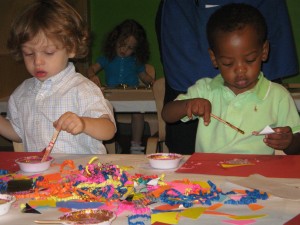 There is still time to apply to free community-based organizations (CBOs) pre-k programs for September but spots are limited. CBO programs are publicly funded (free) but are not in schools. All info and application are available online at the DOE Website.
There is still time to apply to free community-based organizations (CBOs) pre-k programs for September but spots are limited. CBO programs are publicly funded (free) but are not in schools. All info and application are available online at the DOE Website.
